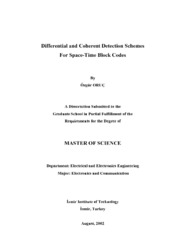Please use this identifier to cite or link to this item:
https://hdl.handle.net/11147/3031Full metadata record
| DC Field | Value | Language |
|---|---|---|
| dc.contributor.advisor | Altınkaya, Mustafa Aziz | - |
| dc.contributor.author | Oruç, Özgür | - |
| dc.date.accessioned | 2014-07-22T13:50:45Z | - |
| dc.date.available | 2014-07-22T13:50:45Z | - |
| dc.date.issued | 2002 | - |
| dc.identifier.uri | http://hdl.handle.net/11147/3031 | - |
| dc.description | Thesis (Master)--Izmir Institute of Technology, Electronics and Communication Engineering, Izmir, 2002 | en_US |
| dc.description | Includes bibliographical references (leaves: 90-94) | en_US |
| dc.description | Text in English; Abstract: Turkish and English | en_US |
| dc.description | xii, 94 leaves | en_US |
| dc.description.abstract | The single most important technique providing reliable communication over wireless channels is diversity. One of the diversity techniques is space diversity. Typical examples of space diversity are multiple transmit and/or receive antenna communications. By employing multiple antennas either at the transmitter or at the receiver, multiple antenna communications introduce a space diversity to combat fading without necessarily sacrificing bandwidth resources; thus they become attractive solutions for broadband wireless applications.Space-time coding is a new diversity method for communication over wireless channels using multiple transmit antennas. Two types of space-time coding have been studied for a few years: trellis and block coding. Space.time trellis codes perform extremely well at the cost of relatively high complexity. Owing to this, in this thesis, space-time block codes are investigated in detail. Not only these codes support an extremely simple maximum likelihood detection algorithm based only on linear processing at the receiver, but also they can be used for multiple transmit antenna differential detection.In this thesis, coherent and differential detection schemes for space-time block coding are investigated in detail over non-dispersive Rayleigh fading channels. In coherent detection systems, Alamouti's and Tarokh's codes with two, three and four transmit antennas are simulated for BPSK and QPSK modulation. Furthermore, Tarokh's and Hughes' differential detection schemes with two transmit antennas are investigated and a unifying approach to these structures is developed with a new design criteria for optimal unitary group codes. Then, the codes chosen by Tarokh and Hughes are simulated using a generalized differential detection scheme for BPSK and QPSK modulation. Moreover, codes of Hochwald are also simulated in order to compare them to the codes of Tarokh. | en_US |
| dc.language.iso | en | en_US |
| dc.publisher | Izmir Institute of Technology | en_US |
| dc.rights | info:eu-repo/semantics/openAccess | en_US |
| dc.subject.lcc | TK5103.4877 .O78 2002 | en |
| dc.subject.lcsh | Space time codes | en |
| dc.subject.lcsh | Wireless communication systems | en |
| dc.title | Differential and Coherent Detection Schemes for Space-Time Block Codes | en_US |
| dc.type | Master Thesis | en_US |
| dc.institutionauthor | Oruç, Özgür | - |
| dc.department | Thesis (Master)--İzmir Institute of Technology, Electrical and Electronics Engineering | en_US |
| dc.relation.publicationcategory | Tez | en_US |
| dc.identifier.wosquality | N/A | - |
| dc.identifier.scopusquality | N/A | - |
| item.openairecristype | http://purl.org/coar/resource_type/c_18cf | - |
| item.languageiso639-1 | en | - |
| item.openairetype | Master Thesis | - |
| item.grantfulltext | open | - |
| item.fulltext | With Fulltext | - |
| item.cerifentitytype | Publications | - |
| Appears in Collections: | Master Degree / Yüksek Lisans Tezleri | |
Files in This Item:
| File | Description | Size | Format | |
|---|---|---|---|---|
| T000133.pdf | MasterThesis | 3.3 MB | Adobe PDF |  View/Open |
CORE Recommender
Page view(s)
242
checked on Mar 31, 2025
Download(s)
90
checked on Mar 31, 2025
Google ScholarTM
Check
Items in GCRIS Repository are protected by copyright, with all rights reserved, unless otherwise indicated.